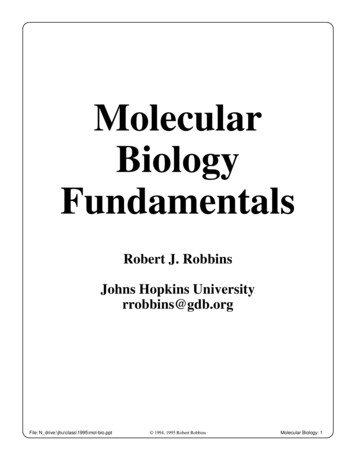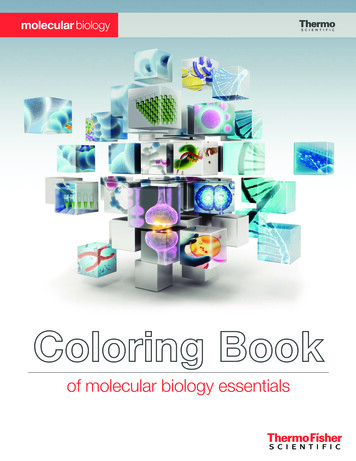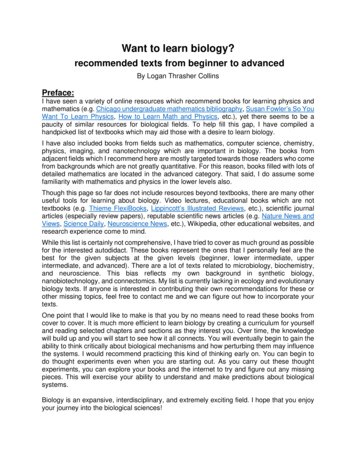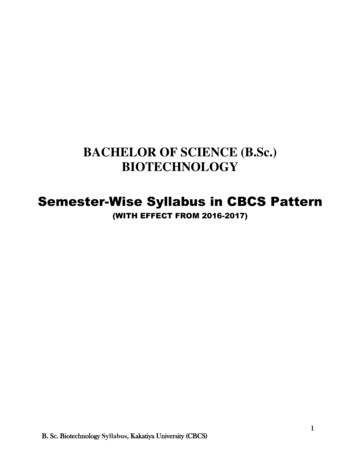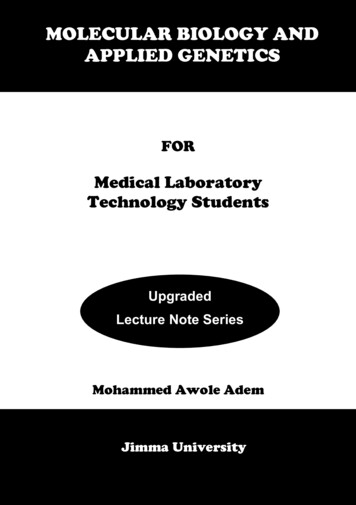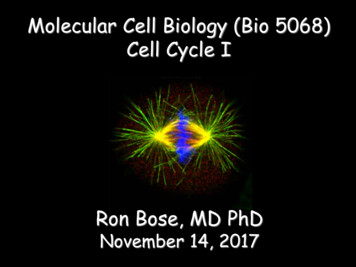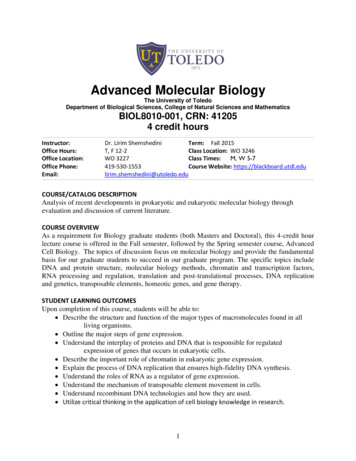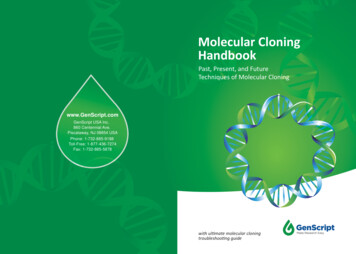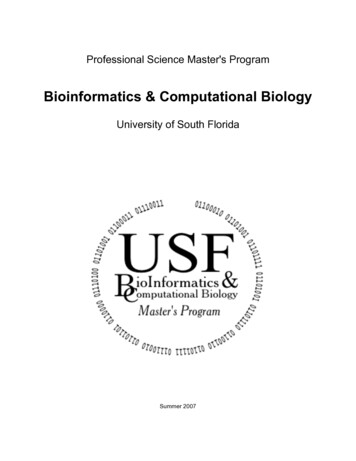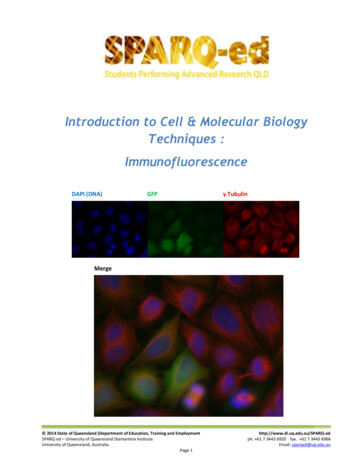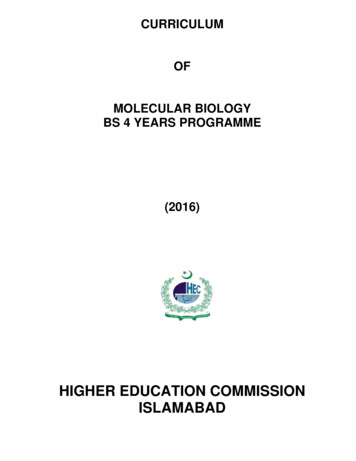
Transcription
CURRICULUMOFMOLECULAR BIOLOGYBS 4 YEARS PROGRAMME(2016)HIGHER EDUCATION COMMISSIONISLAMABAD
CURRICULUM DIVISION, HECProf. Dr. Mukhtar AhmedChairman, HECMr. Fida HussainDirector General (Acad)Ms. Ghayyur FatimaDirector (Curri)Mr. Rizwan ShoukatDeputy Director (Curri)Mr. Abid WahabAssistant Director (Curri)Mr. Riaz-ul-HaqueAssistant Director (Curri)2
CONTENTS1. Introduction62. Objectives of the meeting83. Frame work for BS Molecular Biology(4 years programme)104. List of Elective Courses125. List of Compulsory Courses146. Scheme of Studies for BS Molecular Biology(4 years programme)157. Detail of Compulsory Courses148. List of General Courses259. Detail of General Courses2610. List of Foundation Courses4211. Detail of Foundation Courses4212. List of Major Courses5513. Detail of Major Courses5514. Elective Courses7015. MS & MPhil (2 years) programme in Molecular Biology9216. Recommendations95Composed by: Mr. Zulfiqar Ali, HEC, Islamabad3
PREFACEThe curriculum, with varying definitions, is said to be a plan of the teachinglearning process that students of an academic programme are required toundergo. It includes objectives & learning outcomes, course contents,scheme of studies, teaching methodologies and methods of assessment oflearning. Since knowledge in all disciplines and fields is ]]]]]]expanding at afast pace and new disciplines are also emerging; it is imperative that curriculabe developed and revised accordingly.University Grants Commission (UGC) was designated as the competentauthority to develop, review and revise curricula beyond Class-XII videSection 3, Sub-Section 2 (ii), Act of Parliament No. X of 1976 titled“Supervision of Curricula and Textbooks and Maintenance of Standard ofEducation”. With the repeal of UGC Act, the same function was assigned tothe Higher Education Commission (HEC) under its Ordinance of 2002,Section 10, Sub-Section 1 (v).In compliance with the above provisions, the Curriculum Division of HECundertakes the revision of curricula after every three years through respectiveNational Curriculum Revision Committees (NCRCs) which consist of eminentprofessors and researchers of relevant fields from public and private sectoruniversities, R&D organizations, councils, industry and civil society byseeking nominations from their organizations.In order to impart quality education which is at par with internationalstandards, HEC NCRCs have developed unified templates as guidelines forthe development and revision of curricula in the disciplines of Basic Sciences,Applied Sciences, Social Sciences, Agriculture and Engineering in 2007 and2009.It is hoped that this curriculum document, prepared by the respective NCRC’s,would serve the purpose of meeting our national, social and economic needs,and it would also provide the level of competency specified in PakistanQualification Framework to make it compatible with international educationalstandards. The curriculum is also placed on the website of /RevisedCurricula/Pages/default.aspx(Fida Hussain)Director General (Academics)4
CURRICULUM DEVELOPMENT PROCESSSTAGE-ISTAGE-IISTAGE-IIISTAGE-IVCURRI. UNDERCONSIDERATIONCURRI. IN DRAFTSTAGEFINAL STAGEFOLLOW UPSTUDYCOLLECTION OFRECAPPRAISAL OF 1STDRAFT BY EXP. OFCOL./UNIVPREP. OF FINALCURRI.QUESTIONNAIRECONS. OF CRC.FINALIZATION OFDRAFT BY CRCINCORPORATION OFREC. OF V.C.C.COMMENTSPREP. OF DRAFTBY CRCAPPROVAL OFCURRI.BY V.C.C.PRINTING OFCURRI.REVIEWIMPLE.OF CURRI.BACK TO STAGE-IAbbreviations Used:CRC. Curriculum RevisionCommitteeVCC. Vice Chancellor’s CommitteeEXP. ExpertsCOL. CollegesUNI. UniversitiesPREP. PreparationREC. RecommendationsORIENTATIONCOURSES5
INTRODUCTION:Final meeting of the National Curriculum Revision Committee (NCRC) in thediscipline of Molecular Biology was held on March 14-16, 2016 at HECIslamabad. Following members attended the meeting:Sr. No Name & Address1.2.3.4.5.6.7.Prof. Dr. Anjum Nasim Sabri,Professor / Chairperson,Department of Microbiology and MolecularGenetics, Quaid-e-Azam Campus,University of Punjab, Lahore.Dr. Hajira Sadia(In Place of Dr. Peter John),Assistant Professor,Atta-ur-Rehman School of AppliedBiosciences (ASAB), National University ofScience & Technology, Sector H-12,Islamabad.Dr. Muhammad Saeed,Assistant Professor,Department of Biosciences,COMSAT Institute of InformationTechnology, Park Road, Chak Shahzad,Islamabad.Dr. Bushra Mirza,Professor & Chairperson,Department of Biochemistry,Quaid –I-Azam University, Islamabad.Dr. Nosheen Masood,Assistant Professor,Department of Environmental Sciences,Fatima Jinnah Women University,Rawalpindi.Dr .Wasim Shehzad,Associate Professor /Director,Institute of Biochemistry & Biotechnology,University of Veterinary and AnimalScience, Syed Abdul Qadir Jillani Road,Lahore.Dr. Akhtar Ali.(In Place of Prof. Dr. Masroor Ellahi Babar),Professor / Dean,Department of Molecular Biology,Virtual University of Pakistan,M. A Jinnah Road, r6
8.Dr. Shahid Raza,Dean / Director,Department of Biological Sciences,University of South Asia,47 Tufail Road, Lahore.Prof. Dr. Ghulam Asghar Maka,Professor (Director),Institute of Microbiology,University of Sindh, Jamshoro.Dr. Mir Muhammad Ali Talpur,Associate Professor,Department of Microbiology,Shah Abdul Latif University, Khairpur.Dr. Ali Muhammad Waryah,Assistant Professor,Department of Molecular Biology & HumanGenetics, Liaquat University of Medical &Health Sciences, Jamshoro, Sindh.Member12.Dr. Shahid Ali,Assistant Professor,Centre for Biodiversity & Microbiology,University of Swat, G. T. Road, Odigram,SwatMember13.Dr. Hamid Manzoor,Assistant Professor,Institute of Molecular Biology &Biotechnology, Bahauddin ZakariyaUniversity, Multan.Member14.Dr. Bushra Rashid,Assistant Professor,Centre of Excellence in Molecular Biology(CEMB), University of the Punjab,Lahore.Member15.Dr. Deeba Noreen Baig,Assistant Professor,Department of Biological Sciences,Forman Christian College, Ferozpur Road,Lahore.Member16.Dr. Muhammad Qasim,Assistant Professor,Department of Microbiology,Kohat University of Science & berMember7
Objectives of the meeting: To develop the draft curriculum in the discipline of Molecular Biologyand to bring it par with international standards. To incorporate latest reading and writing material against each course. To bring uniformity and develop minimum baseline courses in each andevery course of study. To make recommendations for promotion/development of thediscipline.The meeting started with the recitation of verses from the Holy Quran by Dr.Muhammad Qasim. Ms. Ghayyur Fatima (Director Curriculum) presided overthe inaugural session. She welcomed the participants on behalf of HEC andthanked the participants for attending the meeting for this cause of nationalsignificance. Ms. Ghayyur Fatima also highlighted brief history of semestersystem implementation in Pakistan. She also briefed about the role of HEC instrengthening the curriculum of Molecular Biology and to bring it at par withinternational standards. Furthermore, she encourages the participants toprepare their suggestions and recommendations for HEC to bringimprovement in current semester system.The committee unanimously agreed upon selecting Prof. Dr. Anjum NasimSabri as Convener and Dr. Muhammad Qasim as Secretary of the NCRC inMolecular Biology. Ms. Ghayyur Fatima requested the convener of thecommittee to start technical session in accordance with the agenda. Prof. Dr.Anjum Nasim Sabri briefed the committee about the background of MolecularBiology degree programme and its importance in biology to meet the demandof local market. She asked the committee members to give their input in thedocument to be drafted at the end of the meeting. It was decided that thegeneral courses, courses from other departments will be same with referenceto contents to already approved HEC curriculum of biological sciences. It isnecessary to maintain equity with reference to first two years.The committee went through the scheme of study for 4-year BSc. (Hons)Molecular Biology programme at structural level and reviewed its courses andcredit hours. Molecular Biology degree programmes of some of internationaluniversities such as Cornell, King’s college, London; University ofBirmingham, The University of Sheffield and Maxwell were also discussed sothat our syllabi meet international standards. Following extensive brainstorming and constructive criticism a list of compulsory, general, foundation,major and elective courses were prepared. These courses were thenarranged in various semesters according to its relevancy and in-linesequence. Prof. Dr. Bushra raises issues related to BS (2 years) degree andcourses requirement for admission in BS (4 years) Molecular Biology and itwas decided that concerned body of the university will adopt its own criteriafor admission and pre-requisite courses. The forum also decided to addforeign language and comparative religion as an optional compulsory course.8
Most of the compulsory courses were adopted as such from already approvedNCRC courses in the discipline of Biochemistry, Biotechnology, Genetics andMicrobiology. To bring uniformity in the courses, it was also decided to adoptsimilar title of the courses which are already taught in Biochemistry,Biotechnology and Microbiology degree programmes. It was also decided thatthe scheme of studies must be flexible and the universities may offer coursesdepending upon the available faculty, expertise and infrastructure. Prof. Dr.Anjum Nasim Sabri requested all members to review the books and add latestbooks in these courses.9
FRAME WORK FOR BS MOLECULAR BIOLOGY(4 YEARS PROGRAMME)Total numbers of Credit hoursDurationSemester durationSemestersCourse Load per SemesterNumber of courses per semester1364 years16-18 weeks0815-18 Cr hr4-6 (not more than 3 lab /practical courses)Compulsorycourses General courses to be chosenrequirements(the from other departmentsstudent has no choice)9 courses9 coursesSubjectSubjectCrCr.Hr1. English I2. English II3. English III /Communicationskills4. English IV/Foreignlanguage5. Pakistan Studies6. Islamic Studies /Ethics/ComparativeReligion7. Mathematics I8. Biostatistics/Mathematics II9. Introduction toComputerNote*Note**25333322332 1Disciplinespecificfoundation Courses10-11 coursesSubjectHr1.2.General GeneticsBiodiversity ofanimals3. Biodiversity of plants4. Biochemistry-I5. Biochemistry-II6. Microbiology7. Cell Biology8. Animal Physiology9. Plant Physiology10. Chemistry11. Ecology andEcosystem12. DevelopmentalBiology13. Endocrinology14. Sociology/Arts/Environmentalcurrent issues/Environmental ethics15. EntrepreneurshipNote***232 12 12 12 12 12 12 12 12 12 12 12 12 12 01. MolecularBiology-I2. MolecularBiology-II3. MolecularGenetics4. *Immunology5. **Virology6. MolecularEcology7. Bioinformatics8. Basic techniquesin MolecularBiology9. Enzymology10. Introduction toOmics11. Biotechnology12. Cell and tissueCulture13. Biosafety andBioethicsCr.Hr2 12 12 12 12 12 12 11 22 12 02 12 12 034*University may recommend other General courses according to theiravailable faculty and expertise.** University may recommend any other course in lieu of Mathematics II.*** University may recommend other courses according to their availablefaculty i.e. Zoology, Botany, Biotechnology, Animal/Human/PlantPhysiology, Chemistry/Biochemistry, Endocrinology, Ecology and10
Ecosystem, Developmental Biology, Plant diversity and Genetics,Microbiology and Molecular Genetics.* General Immunology** General VirologyMajor courses including researchproject/internshipElective Courses within themajor11-13 courses4 coursesSubject1. AdvancedTechniquesinMolecular Biology2. Gene therapy3. Cell signaling4. Recombinant DNA technology5. Molecular Evolution6. Genomics7. Transcriptomics8. Proteomics9. Molecules to the Market10. Molecular Diagnostics11. Quantitative Biology12. SkillsandResearchMethodology13. Immunogenetics14. Molecular Toxicology15. Molecular Pharmacology16. Bionanotechnology17. Research Project46Cr. hr1 23 03 02 12 12 12 12 12 13 02 12 1SubjectElective IElective IIElective IIIElective IVCr. hr2 12 12 12 13 00 612**** Student may take 13 courses out of the list of 17 courses in major otherthan Research Project.11
List of Elective Courses:University may recommend elective courses according to facilities within 16.17.18.19.20.21.22.23.24.25.26.DNA Damage and RepairBiophysics and Computational BiologyVaccinologyEpigeneticsMolecular BreedingHuman Genetics and Chromosomal DisordersNeurobiologyGenetically Modified OrganismsComputer Graphics and Molecular BiologyForensic BiologyMacromolecular CrystallographyPlant Molecular GeneticsProbioticsBiodegradation & BioremediationInfectious DiseasesFood Preservation TechnologyEpidemiology: Analytical and Experimental ApproachesAdvances in Microscopy and Image AnalysisBiosensorsBiofuels and Bio-refineriesAntimicrobials and ChemotherapeuticsDrug DevelopmentStem cells and Gene Therapy Regenerative MedicineCancer BiologyMolecular VirologyAnimal Molecular Biology12
SCHEME OF STUDIES FOR BS MOLECULAR BIOLOGY(4 YEARS PROGRAMME)Semester/ yearFirstSecondThirdFourthFifthName of subjectENGLISH-IPAKISTAN STUDIESMATH- IGENERAL-IGENERAL-IIFOUNDATION-ICredits0302032 12 12 117ENGLISH-II03ISLAMIC STUDIES / ETHICS02MATH/STAT-II/UNIV. 03OPTIONALGENERAL-III2 1GENERAL-IV2 1FOUNDATION-II2 117COMPUTER APPLICATION03ENGLISH-III/COMMUNICATION 03SKILLSGENERAL-V2 1GENERAL-VI2 1FOUNDATION-II2 1FOUNDATION-III2 118ENGLISH-IV/FOREIGN03LANGUAGE UNIV. OPTIONALGENERAL-VII2 1GENERAL-VIII2 1FOUNDATION-IV2 1FOUNDATION-V2 1FOUNDATION-VI2 118FOUNDATION-VII2 1FOUNDATION-VIII2 1FOUNDATION-IX2 1MAJOR- I2 1MAJOR- II2 1MAJOR- III2 11813
SixthSeventhEighthFOUNDATION- XMAJOR- IVMAJOR- VMAJOR- VIMAJOR- VIIMAJOR-VIII2 12 12 12 12 12 118MAJOR- IX2 1MAJOR- X2 1ELECTIVE-I2 1ELECTIVE-II2 1ELECTIVE PAPER/ RESEARCH 03PROJECT15MAJOR- XI2 1MAJOR-XII2 1ELECTIVE-I2 1ELECTIVE-II2 1ELECTIVE PAPER /RESEARCH 03PROJECT15136Total credit hoursList of Compulsory Courses:1.2.3.4.5.6.7.8.9.English IEnglish IIEnglish III/ Communication skillsEnglish IV/ Foreign languagePakistan StudiesIslamic Studies / Ethics /Comparative ReligionMathematics IBiostatistics/Mathematics IIIntroduction to Computer14
DETAIL OF COMPULSORY COURSESENGLISH I (FUNCTIONAL ENGLISH)Credit Hrs 3 0Objectives: Enhance language skills and develop critical thinking.Course Contents:Basics of GrammarParts of speech and use of articlesSentence structure, active and passive voicePractice in unified sentenceAnalysis of phrase, clause and sentence structureTransitive and intransitive verbsPunctuation and spellingComprehensionAnswers to questions on a given textDiscussionGeneral topics and every-day conversation (topics for discussion to beat the discretion of the teacher keeping in view the level of students)ListeningTo be improved by showing documentaries/films carefully selected bysubject teachersTranslation skillsUrdu to EnglishParagraph writingTopics to be chosen at the discretion of the teacherPresentation skillsIntroductionNote: Extensive reading is required for vocabulary buildingRECOMMENDED BOOKS:1.Functional Englisha)Grammar1. Practical English Grammar by A. J. Thomson and A. V. Martinet.Exercises 1. Third edition. Oxford University Press. 1997. ISBN01943134922. Practical English Grammar by A. J. Thomson and A. V. Martinet.Exercises 2. Third edition. Oxford University Press. 1997. ISBN0194313506b)Writing3 Writing. Intermediate by Marie-Christine Boutin, Suzanne Brinandand Francoise Grellet. Oxford Supplementary Skills. FourthImpression 1993. ISBN 0 19 435405 7 Pages 20-27 and 35-41.15
c)Reading/Comprehension4.Reading. Upper Intermediate. Brain Tomlinson and Rod Ellis.Oxford Supplementary Skills. Third Impression 1992. ISBN 0 19453402 2.d)SpeakingENGLISH II (COMMUNICATION SKILLS)Credit Hrs 3 0Objectives: Enable the students to meet their real life communicationneeds.Course Contents:Paragraph writingPractice in writing a good, unified and coherent paragraphEssay writingIntroductionCV and job applicationTranslation skillsUrdu to EnglishStudy skillsSkimming and scanning, intensive and extensive, and speed reading,summary and précis writing and comprehensionAcademic skillsLetter/memo writing, minutes of meetings, use of library and internetPresentation skillsPersonality development (emphasis on content, style andpronunciation)Note: documentaries to be shown for discussion and reviewRECOMMENDED BOOKS:Communication Skillsa)Grammar1.Practical English Grammar by A. J. Thomson and A. V. Martinet.Exercises 2. Third edition. Oxford University Press 1986. ISBN0 19 431350 6.b)Writing1.Writing. Intermediate by Marie-Christine Boutin, SuzanneBrinand and Francoise Grellet. Oxford Supplementary Skills.Fourth Impression 1993. ISBN 019 435405 7 Pages 45-53 (notetaking).16
2.c)Writing. Upper-Intermediate by Rob Nolasco. OxfordSupplementary Skills. Fourth Impression 1992. ISBN 0 19435406 5 (particularly good for writing memos, introduction topresentations, descriptive and argumentative writing).Reading1.Reading. Advanced. Brian Tomlinson and Rod Ellis. OxfordSupplementary Skills. Third Impression 1991. ISBN 0 19 4534030.2.Reading and Study Skills by John Langan3.Study Skills by Richard York.ENGLISH III (TECHNICAL WRITING ANDPRESENTATION SKILLS)Objectives: Enhance language skills and develop critical thinkingCourse Contents:Presentation skillsEssay writingDescriptive, narrative, discursive, argumentativeAcademic writingHow to write a proposal for research paper/term paperHow to write a research paper/term paper (emphasis on style,content, language, form, clarity, consistency)Technical Report writingProgress report writingNote: Extensive reading is required for vocabulary buildingRECOMMENDED BOOKS:Technical Writing and Presentation Skillsa)Essay Writing and Academic Writing1.Writing. Advanced by Ron White. Oxford SupplementarySkills. Third Impression 1992. ISBN 0 19 435407 3(particularly suitable for discursive, descriptive,argumentative and report writing).2.3.College Writing Skills by John Langan. McGraw-HillHigher Education. 2004.Patterns of College Writing (4th edition) by Laurie G.Kirszner and Stephen R. Mandell. St. Martin’s Press.17
b)Presentation Skillsc)ReadingThe Mercury Reader. A Custom Publication. Compiled byNorthern Illinois University. General Editors: Janice Neulib;Kathleen Shine Cain; Stephen Ruffus and Maurice Scharton. (Areader which will give students exposure to the best of twentiethcentury literature, without taxing the taste of engineeringstudents).PAKISTAN STUDIESCredit Hrs 3 0Introduction/Objectives: Develop vision of historical perspective, government, politics,contemporary Pakistan, ideological background of Pakistan. Study the process of governance, national development, issues arisingin the modern age and posing challenges to Pakistan.Course Outline:1. Historical Perspectivea. Ideological rationale with special reference to Sir Syed Ahmed Khan,Allama Muhammad Iqbal and Quaid-e-Azam Muhammad Ali Jinnah.b. Factors leading to Muslim separatismc. People and Landi. Indus Civilizationii. Muslim adventiii. Location and geo-physical features.2. Government and Politics in PakistanPolitical and constitutional phases:a. 1947-58b. 1958-71c. 1971-77d. 1977-88e. 1988-99f. 1999 onward3. Contemporary Pakistana. Economic institutions and issuesb. Society and social structurec. Ethnicityd. Foreign policy of Pakistan and challengese. Futuristic outlook of PakistanRECOMMENDED BOOKS:1.Burki, Shahid Javed. State & Society in Pakistan, The MacMillan PressLtd 1980.18
2.3.4.5.6.7.8.9.10.11.12.13.14.Akbar, S. Zaidi. Issue in Pakistan’s Economy. Karachi: Oxford UniversityPress, 2000.S. M. Burke and Lawrence Ziring. Pakistan’s Foreign policy: An Historicalanalysis. Karachi: Oxford University Press, 1993.Mehmood, Safdar. Pakistan Political Roots & Development. Lahore,1994.Wilcox, Wayne. The Emergence of Bangladesh, Washington: AmericanEnterprise, Institute of Public Policy Research, 1972.Mehmood, Safdar. Pakistan Kayyun Toota, Lahore: Idara-e-Saqafat-eIslamia, Club Road, nd.Amin, Tahir. Ethno - National Movement in Pakistan, Islamabad: Instituteof Policy Studies, Islamabad.Ziring, Lawrence. Enigma of Political Development. Kent England: WmDawson & sons Ltd, 1980.Zahid, Ansar. History & Culture of Sindh. Karachi: Royal Book Company,1980.Afzal, M. Rafique. Political Parties in Pakistan, Vol. I, II & III. Islamabad:National Institute of Historical and cultural Research, 1998.Sayeed, Khalid Bin. The Political System of Pakistan. Boston: HoughtonMifflin, 1967.Aziz, K. K. Party, Politics in Pakistan, Islamabad: National Commissionon Historical and Cultural Research, 1976.Muhammad Waseem, Pakistan Under Martial Law, Lahore: Vanguard,1987.Haq, Noor ul. Making of Pakistan: The Military Perspective. Islamabad:National Commission on Historical and Cultural Research, 1993.19
ISLAMIC STUDIESCredit Hrs 3 0Objectives:This course is aimed at:1 To provide Basic information about Islamic Studies2 To enhance understanding of the students regarding Islamic Civilization3 To improve Students skill to perform prayers and other worships4 To enhance the skill of the students for understanding of issues relatedto faith and religious life.Detail of Courses:Introduction to Quranic Studies1) Basic Concepts of Quran2) History of Quran3) Uloom-ul-QuranStudy of Selected Text of Holly Quran1) Verses of Surah Al-Baqara Related to Faith (Verse No-284-286)2) Verses of Surah Al-Hujrat Related to Adab Al-Nabi(Verse No-1-18)3) Verses of Surah Al-Mumanoon Related to Characteristics of faithful(Verse No-1-11)4) Verses of Surah al-Furqan Related to Social Ethics (Verse No.63-77)5) Verses of Surah Al-Inam Related to Ihkam (Verse No-152-154)Study of Selected Text of Holly Quran1) Verses of Surah Al-Ihzab Related to Adab al-Nabi (Verse No.6, 21,40, 56, 57, 58.)2) Verses of Surah Al-Hashar (18,19,20) Related to thinking, Day ofJudgment3) Verses of Surah Al-Saf Related to Tafakar, Tadabar (Verse No-1,14)Seerat of Holy Prophet (S.A.W) I1) Life of Muhammad Bin Abdullah ( Before Prophet Hood)2) Life of Holy Prophet (S.A.W) in Makkah3) Important Lessons Derived from the life of Holy Prophet in MakkahSeerat of Holy Prophet (S.A.W) II1) Life of Holy Prophet (S.A.W) in Madina2) Important Events of Life Holy Prophet in Madina3) Important Lessons Derived from the life of Holy Prophet in MadinaIntroduction to Sunnah1) Basic Concepts of Hadith2) History of Hadith20
3)4)5)6)Kinds of HadithUloom –ul-HadithSunnah & HadithLegal Position of SunnahSelected Study from Text of HadithIntroduction to Islamic Law & Jurisprudence1)2)3)4)5)Basic Concepts of Islamic Law & JurisprudenceHistory & Importance of Islamic Law & JurisprudenceSources of Islamic Law & JurisprudenceNature of Differences in Islamic LawIslam and SectarianismIslamic Culture & Civilization1)2)3)4)Basic Concepts of Islamic Culture & CivilizationHistorical Development of Islamic Culture & CivilizationCharacteristics of Islamic Culture & CivilizationIslamic Culture & Civilization and Contemporary IssuesIslam & Science1) Basic Concepts of Islam & Science2) Contributions of Muslims in the Development of Science3) Quran & ScienceIslamic Economic System1)2)3)4)Basic Concepts of Islamic Economic SystemMeans of Distribution of wealth in Islamic EconomicsIslamic Concept of RibaIslamic Ways of Trade & CommercePolitical System of Islam1) Basic Concepts of Islamic Political System2) Islamic Concept of Sovereignty3) Basic Institutions of Govt. in IslamIslamic History1) Period of Khlaft-E-Rashida2) Period of Ummayyads3) Period of AbbasidsSocial System of Islam1) Basic Concepts of Social System of Islam2) Elements of Family3) Ethical Values of IslamReference Books:1)Hameed ullah Muhammad, “Emergence of Islam” , IRI,Islamabad21
2)3)4)5)6)7)8)9)1.Hameed ullah Muhammad, “Muslim Conduct of State”Hameed ullah Muhammad, ‘Introduction to IslamMulana Muhammad Yousaf Islahi,”Hussain Hamid Hassan, “An Introduction to the Study of Islamic Law”leaf Publication Islamabad, Pakistan.Ahmad Hasan, “Principles of Islamic Jurisprudence” Islamic ResearchInstitute, International Islamic University, Islamabad (1993)Mir Waliullah, “Muslim Jurisprudence and the Quranic Law of Crimes”Islamic Book Service (1982)H. S. Bhatia, “Studies in Islamic Law, Religion and Society” Deep & DeepPublications New Delhi (1989)Dr. Muhammad Zia-ul-Haq, “Introduction to Al Sharia Al Islamia” AllamaIqbal Open University, Islamabad (2001)MATHEMATICS I (ALGEBRA)Prerequisite(s): Mathematics at secondary levelCredit Hours:3 0Specific Objectives of the Course: To prepare the students, not majoringin mathematics, with the essential tools of algebra to apply the concepts andthe techniques in their respective disciplines.Course Outline:Preliminaries: Real-number system, complex numbers, introduction to sets,set operations, functions, types of functions. Matrices: Introduction tomatrices, types, matrix inverse, determinants, system of linear equations,Cramer’s rule.Quadratic Equations: Solution of quadratic equations, qualitative analysis ofroots of a quadratic equations, equations reducible to quadratic equations,cube roots of unity, relation between roots and coefficients of quadraticequations.Sequences and Series: Arithmetic progression, geometric progression,harmonic progression. Binomial Theorem: Introduction to mathematicalinduction, binomial theorem with rational and irrational indices. Trigonometry:Fundamentals of trigonometry, trigonometric identities.Recommended Books:1. Dolciani MP, Wooton W, Beckenback EF, Sharron S, Algebra 2 andTrigonometry, 1978, Houghton & Mifflin, Boston (suggested text)2. Kaufmann JE, College Algebra and Trigonometry, 1987, PWS-KentCompany, Boston3. Swokowski EW, Fundamentals of Algebra and Trigonometry (6th edition),1986, PWS-Kent Company, Boston22
BIO STATISTICSCREDIT HOURS 03LEARNING OUTCOMES:Students will able to:1. Explain what is meant by statistical observation , inference, biologicalvariance2. Distinguish between populations and samples.3. Distinguish between population parameters and sample statistics.4. Compute a sample mean, sample variance, and sample standarddeviation.5. Compute a population mean, population variance, and populationstandard deviation.COURSE CONTENTS:Introduction to Biostatistics and its scope in Molecular biology; Collection ofPrimary and Secondary data; editing of data; Presentation of data:Tabulation, Classification, Visual Presentation (Diagrams and Graphs);Measures of Central Tendency: Arithmetic Mean by direct and short-cutmethod, Geometric Mean, Harmonic Mean, Mode, Median, ED50 (LD50 indetail ), Quartile; Measures of Dispersion: Range, Quartile Deviation, MeanDeviation, Standard Deviation by direct and short-cut method, Variance, andtheir Coefficient; Correlation: Simple Correlation Table, Rank Correlation,Partial and Multiple Correlation; Regression and method of least square;Probability: Concept of Probability, Laws of Probability; Permutation andCombination; Probability distributions: Binomial distribution, Poissondistribution and their fitting to observed data, Normal distribution; Samplingand Basic Design; Hypothesis Testing; Chi-square test, Student’s t-test,Analysis of variance; Multivariate analysis; Knowledge of statistical software;Laboratory Experiments pertaining to the course.RECOMMENDED BOOKS:1. Fernholz, L.T, Morgenlhaler, S. and Stahel, W. 2000. Statistics inGenetics and in Environmental Sciences, Birkhauser Verlag, Switzerland.2. Quinn, G., 2002. Experimental Design and Data Analysis for Biologists,Cambridge University Press, U.S.A.3. Gerstman, B.B. 2014. Basic Biostatistics: Statistics for Public HealthPractice. 2nd Edition. Jones and Bartlett learning publications. 5 wallstreet Burlington MA01803.4. Glover, T. and Mitchell, K., 2015. An Introduction to Biostatistics, ThirdEdition 3rd Edition . Waveland Press, Inc. Long grove, IL,60047-9580.23
INTRODUCTION TO COMPUTERCREDIT HOURS 3 0LEARNING OUTCOMES:Students will develop:1. The ability to solve problems in the discipline by using computing skills2. The ability to analyze data statistically, and carefully interpret results ofexperiments after drawing valid reasonable conclusions.3. The ability to search the relevant literature and to produce a disciplinespecific technical document.4. The ability to give an effective presentation using different software.COURSE CONTENTS: Introduction to Computer and Windows.Word processing (Microsoft Word).Spread Sheets (Microsoft Excel) and other related software packages(at least two).Internet access and different data bases available on the Internet.RECOMMENDED BOOKS:1. Parsons, J.J., 2016. New Perspectives on Computer ConceptsIntroductory 18th Edition. Cengage learning 20 Channel Centre StreetBoston, MA 02210, USA.2. Randal E. Bryant, R.E. and O' Hallaron, D.R., 2015. Computer systems: AProgrammer’s Perspective. Pearson Education Press.3. Mayword, A., 2016. Microsoft Office 2016: Tips and TricksLIST OF GENERAL COURSES1.2.3.4.5.6.7.8.9.10.11.12.13.14.15.General GeneticsBiodiversity of animalsBiodiversity of l BiologyAnimal PhysiologyPlant PhysiologyChemistryEcology and EcosystemDevelopmental BiologyEndocrinologySociology/Arts/Current Issues in Environment/Environmental EthicsEntrepreneurship24
DETAIL OF GENERAL COURSESGENERAL GENETICSCREDIT HOURS 2 1LEARNING OUTCOMES:Students will be able to:1. Learn the classical genetics with emphasis on basic principles ofinheritance and Mendelian Genetics.2. Apply what they learn in genetics by applying this knowledge in avariety of problem-solving situations.COURSE CONTENTS:Definition and genesis (history) of genetics. Heredity and variation.Chromosomal theory of inheritance. Mendel’s laws o
Molecular Biology programme at structural level and reviewed its courses and credit hours. Molecular Biology degree programmes of some of international universities such as Cornell, King’s college, London; University of Birmingham, The University of Sheffield and Maxwell were also di
